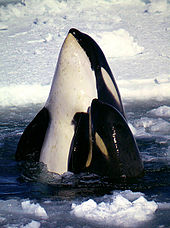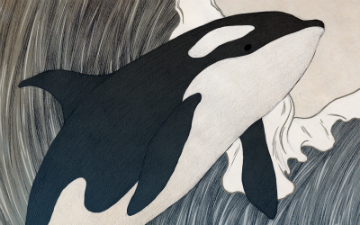| Killer whale[1] | |
|---|---|
 |
|
| Transient killer whales near Unimak Island, eastern Aleutian Islands, Alaska | |
| Conservation status | |
| Scientific classification | |
| Kingdom: | Animalia |
| Phylum: | Chordata |
| Class: | Mammalia |
| Order: | Cetacea |
| Suborder: | Odontoceti |
| Family: | Delphinidae |
| Genus: | Orcinus Fitzinger, 1860 [3] |
| Species: | O. orca |
| Binomial name | |
| Orcinus orca | |
The killer whale (Orcinus orca), commonly referred to as the orca whale or orca, and less commonly as the blackfish, is a toothed whale belonging to the oceanic dolphin family. Killer whales are found in all oceans, from the frigid Arctic and Antarctic regions to tropical seas. Killer whales as a species have a diverse diet, although individual populations often specialize in particular types of prey. Some feed exclusively on fish, while others hunt marine mammals such as sea lions, seals, walruses and even large whales. Killer whales are regarded as apex predators, lacking natural predators.
Killer whales are highly social; some populations are composed of matrilineal family groups which are the most stable of any animal species.[5] Their sophisticated hunting techniques and vocal behaviors, which are often specific to a particular group and passed across generations, have been described as manifestations of culture.[6]
The IUCN currently assesses the orca’s conservation status as data deficient because of the likelihood that two or more killer whale types are separate species. Some local populations are considered threatened or endangered due to prey depletion, habitat loss, pollution (by PCBs), capture for marine mammal parks, and conflicts with fisheries. In late 2005, the “southern resident” population of killer whales that inhabits British Columbia and Washington state waters were placed on the U.S. Endangered Species list.
Wild killer whales are not considered a threat to humans,[7] although there have been cases of captives killing or injuring their handlers at marine theme parks. Killer whales feature strongly in the mythologies of indigenous cultures, with their reputation ranging from being the souls of humans to merciless killers.
Killer Whales Target Prey<== Click here to watch
Types
There are three to five types of killer whales that may be distinct enough to be considered different races,[16] subspecies, or possibly even species.[17] The IUCN reported in 2008, “The taxonomy of this genus is clearly in need of review, and it is likely that O. orca will be split into a number of different species or at least subspecies over the next few years.”[2] In the 1970s and 1980s, research off the west coast of Canada and the United States identified the following three types:
- Resident: These are the most commonly sighted of the three populations in the coastal waters of the northeast Pacific. Residents’ diet consists primarily of fish and sometimes squid, and they live in complex and cohesive family groups called pods.[18] Female residents characteristically have a rounded dorsal fin tip that terminates in a sharp corner.[19] They visit the same areas consistently. British Columbia and Washington resident populations are amongst the most-intensively studied marine mammals. Researchers have identified and named over 300 killer whales over the past 30 years.[20]
- Transient: The diet of these whales consists almost exclusively of marine mammals; they do not eat fish.[19] Transients generally travel in small groups, usually of two to six animals, and have less persistent family bonds than residents. Transients vocalize in less variable and less complex dialects. Female transients are characterized by more triangular and pointed dorsal fins than those of residents.[19] The gray or white area around the dorsal fin, known as the “saddle patch”, often contains some black colouring in residents. However, the saddle patches of transients are solid and uniformly gray.[19] Transients roam widely along the coast; some individuals have been sighted in both southern Alaska and California.[21]
- Offshore: A third population of killer whales in the northeast Pacific was discovered in 1988, when a humpback whale researcher observed them in open water. As their name suggests, they travel far from shore and feed primarily on schooling fish.[22] However, because of the large, scarred and nicked dorsal fins resembling those of mammal-hunting transients, they may also eat mammals and sharks. They have mostly been encountered off the west coast of Vancouver Island and near the Queen Charlotte Islands. Offshores typically congregate in groups of 20–75, with occasional sightings of larger groups of up to 200.[23] Currently, little is known about their habits, but they are genetically distinct from residents and transients. Offshores appear to be smaller than the others, and females are characterized by dorsal fin tips that are continuously rounded.[19]

Type C killer whales in the Ross Sea. The eye patch slants forward.
Transients and residents live in the same areas, but avoid each other.[24] The name “transient” originated from the belief that these killer whales were outcasts from larger resident pods. Researchers later discovered transients are not born into resident pods or vice-versa. The evolutionary split between the two groups is believed to have begun two million years ago.[25] Genetic data indicates that the types have not interbred for up to 10,000 years.[26]
Other populations have not been as well studied, although specialized fish-eating and mammal-eating killer whales have been distinguished elsewhere.[27] Separate populations of fish-eating and mammal-eating killer whales have been identified around the United Kingdom.[28][29] Fish-eating killer whales in Alaska and Norway have resident-like social structures, while mammal-eating killer whales in Argentina and the Crozet Islands behave more like transients.[30]
Three types have been documented in the Antarctic. Two dwarf species, named Orcinus nanus and Orcinus glacialis, were described during the 1980s by Soviet researchers, but most cetacean researchers are skeptical about their status, and it is difficult to link these directly to the types described below.[17]
- Type A looks like a “typical” killer whale, a large, black and white form with a medium-sized white eye patch, living in open water and feeding mostly on minke whales.[17]
- Type B is smaller than Type A. It has a large white eye patch. Most of the dark parts of its body are medium gray instead of black, although it has a dark gray patch called a “dorsal cape”[31] stretching back from its forehead to just behind its dorsal fin. The white areas are stained slightly yellow. It feeds mostly on seals.[17]
- Type C is the smallest type and lives in larger groups than the others. Its eye patch is distinctively slanted forwards, rather than parallel to the body axis. Like Type B, it is primarily white and medium gray, with a dark gray dorsal cape and yellow-tinged patches. Its only observed prey is the Antarctic Cod.[17]
- Type D was identified based on photographs of a 1955 mass stranding in New Zealand and six at-sea sightings since 2004. Immediately recognizable by its extremely small white eye patch, shorter than usual dorsal fin, and bulbous head (similar to a pilot whale). Its geographic range appears to be circumglobal in subantarctic waters between latitudes 40°S and 60°S. And although nothing is known about the Type D diet, it is suspected to include fish because groups have been photographed around longline vessels where they reportedly depredate Patagonian toothfish (Dissostichus eleginoides).[32][33]
Types B and C live close to the ice pack, and diatoms in these waters may be responsible for the yellowish coloring of both types.[17][34] Mitochondrial DNA sequences support the theory that these are separate species that have recently diverged.[35] More recently, complete mitochondrial sequencing indicates that the two Antarctic groups that eat seals and fish should be recognized as distinct species, as should the North Pacific transients, leaving the others as subspecies pending additional data.[36]
Research is ongoing into the genetic relationships among killer whale types, and whether the types that have been identified represent deep evolutionary trends. For example, it was long thought that mammal-eating killer whales were likely to be closely related to other mammal-eating killer whales from different regions, but genetic testing refuted this hypothesis.[37]
Description

Size comparison to an average human.
Killer whales distinctively bear a black back, white chest and sides, and a white patch above and behind the eye. Calves are born with a yellowish or orange tint, which fades to white. Killer whales have a heavy and robust body[38] with a large dorsal fin up to 2 metres (6.6 ft) tall. Behind the fin, they have a dark grey “saddle patch” across the back. Antarctic killer whales may have pale grey to nearly white backs. Adult killer whales are very distinctive and are not usually confused with any other sea creature.[39] When seen from a distance, juveniles can be confused with other cetacean species such as the false killer whale or Risso’s dolphin.[40] The killer whale’s teeth are very strong and covered in enamel. Its jaws are a powerful gripping apparatus, as the upper teeth fall into the gaps between the lower teeth when the mouth is closed. The front teeth are inclined slightly forward and outward, thus allowing the killer whale to withstand powerful jerking movements from its prey while the middle and back teeth hold it firmly in place.[41]
Killer whales are the largest extant members of the dolphin family. Males typically range from 6 to 8 metres (20–26 ft) long and weigh in excess of 6 tonnes (5.9 long tons; 6.6 short tons).[42] Females are smaller, generally ranging from 5 to 7 metres (16–23 ft) and weighing about 3 to 4 tonnes (3.0 to 3.9 long tons; 3.3 to 4.4 short tons).[42] The largest male killer whale on record was 9.8 metres (32 ft), weighing over 10 tonnes (9.8 long tons; 11 short tons), while the largest female was 8.5 metres (28 ft), weighing 7.5 tonnes (7.4 long tons; 8.3 short tons).[43] Calves at birth weigh about 180 kilograms (400 lb) and are about 2.4 metres (7.9 ft) long.[44][45] The killer whale’s large size and strength make it among the fastest marine mammals, able to reach speeds in excess of 30 knots (56 km/h).[46] The skeleton of the killer whale is of the typical delphinid structure but is more robust in all respects.[47] The killer whale’s integument, unlike that of most other dolphin species, is characterised by a well-developed dermal layer with a dense network of fascicles of collagen fibers.[48]
Killer whale pectoral fins are large and rounded, resembling paddles. Males have significantly larger pectoral fins than females. At about 1.8 metres (5.9 ft) the male’s dorsal fin is more than twice the size of the female’s and is more of a triangular shape—a tall, elongated isosceles triangle—whereas hers is shorter and more curved.[49] Males and females also have different patterns of black and white skin in the genital area.[50] Sexual dimorphism is also apparent in the skull; adult males have a longer lower jaw than females, and have a larger occipital crest.[48]
Individual killer whales can often be identified from the dorsal fin and saddle patch. Variations such as nicks, scratches, and tears on the dorsal fin and the pattern of white or grey in the saddle patch are unique. Published directories contain identifying photographs and names for hundreds of North Pacific animals. Photo identification has enabled the local population of killer whales to be counted each year rather than estimated and has enabled great insight into lifecycles and social structures.[51]
White killer whales occur sporadically among normal killer whales, but are rare. They have been spotted in the northern Bering Sea and around St. Lawrence Island, and near the Russian coast.[52][23] In February 2008, a white killer whale was photographed 2 miles (3.2 km) off Kanaga Volcano in the Aleutian Islands.[52][23]
Killer whales have good eyesight above and below the water, excellent hearing, and a good sense of touch. They have exceptionally sophisticated echolocation abilities, detecting the location and characteristics of prey and other objects in their environment by emitting clicks and listening for echoes.[53]
http://en.wikipedia.org/wiki/Killer_whale







